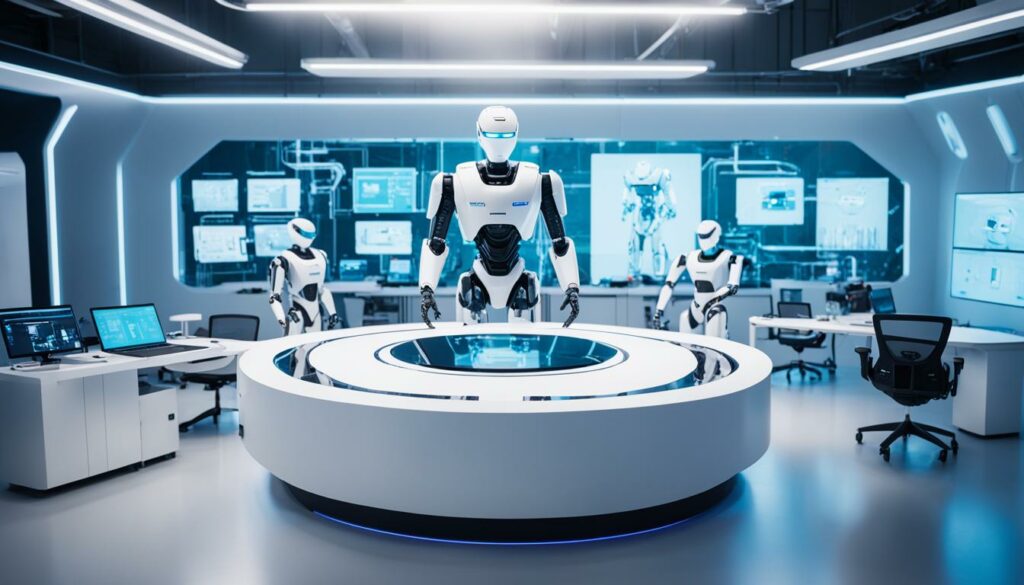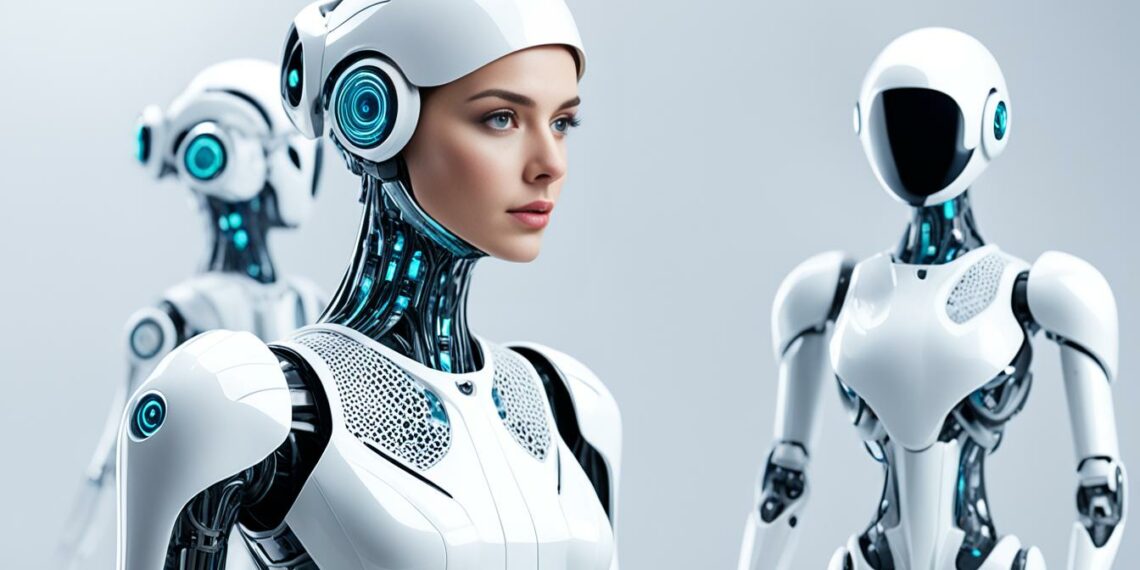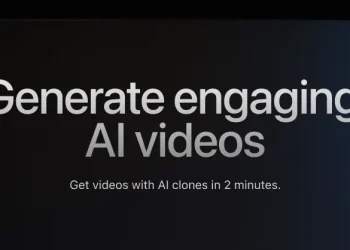Did you know AI tools can cut design time by up to 80%? This shows how artificial intelligence is changing product design. In today’s fast market, AI in product design brings new ways to be creative, efficient, and meet consumer needs. It uses generative design for many possibilities and intelligent design optimization to make products better. We’ll look at how AI is changing creation in this article.
Key Takeaways
- AI speeds up design by making quick changes.
- Generative design boosts creativity and opens new chances for product makers.
- AI-made ideas match market trends and what consumers want.
- Machine learning algorithms are key in analyzing data and coming up with new designs.
- Working together, human designers and AI create solutions for the market.
- Generative AI helps make products better and more sustainable.
The Rise of AI in Product Design
AI is changing how we design products, making them smarter and more creative. McKinsey found that 72% of companies now use AI in their work. This includes many areas, with half using AI in two or more places. AI helps brands make things more efficient and creative.
Adobe’s AI tool, Sensei, cuts down the time designers spend on tasks like image recognition and color matching. This lets designers focus more on making things look good. AI helps by finding patterns and trends, making it easier to make smart design choices.
Tools like Uizard and Framer use AI to help web developers and designers work faster. By automating tasks, designers can spend more time on being creative. AI is great at looking at big data to make products that users will love.
Understanding Generative Design
Generative design uses AI to create many design options from certain rules and needs. It’s a new way that looks at data on products, trends, and what people like. This method uses computers to find the best designs that look good and work well.
What is Generative Design?
Generative design makes lots of design choices with complex algorithms. This lets teams check out and compare many options at once. It’s different from other methods that need a human to start with a design. This makes it faster and more creative.
Companies like those in cars, planes, and sports gear use it to make things lighter, cheaper, and better.
Key Technologies Behind Generative Design
Generative design relies on advanced AI and computer tools. Tools like Fusion 360 and Creo Generative Design make making designs easier. They help with making complex designs for 3D printing and working together in teams.
| Industry | Application of Generative Design | Benefits |
|---|---|---|
| Automotive | Reducing component weights | Improved design weaknesses, decreased time to market |
| Aerospace | Enhancing strength and lowering fuel consumption | Cost reductions, optimized resource usage |
| Sports Equipment | Improving product performance | Reduced production costs, increased customization |
Generative design makes making new products faster and helps teams work better together. It lets both experts and non-experts help with designs. As more companies use this tech, they can make and bring out new products quicker and in a more eco-friendly way.
Benefits of AI in Product Design
Using AI in product design brings many big advantages. It changes how developers and designers work. It makes things more efficient and helps with new ideas.
Accelerated Innovation
AI lets designers work faster than ever. They can try out many different ideas quickly. This leads to accelerated innovation.
AI tools give insights that help with new ideas and improving old ones. It makes exploring a million design changes possible.
Enhanced Creativity and Personalization
Adding AI boosts enhanced creativity. It gives designers insights from how customers behave. This helps make products that fit what people like.
AI lets designers try out many different designs. It makes sure products meet what customers want, keeping them happy and loyal.
Cost Reduction and Efficiency
AI helps save money by reducing the need for many prototypes. This saves resources and cuts costs. Design work gets better and more efficient with automation.
AI lets designers test and improve products without making real prototypes. This means products are likely to be better quality.
| Benefit | Description |
|---|---|
| Accelerated Innovation | Streamlined processes lead to much faster ideation cycles. |
| Enhanced Creativity | Provides insights for personalized and unique designs. |
| Cost Efficiency | Reduces waste and minimizes the need for physical prototyping. |
| Improved Quality | AI simulations enhance product testing and refinement. |
AI is changing how products are made in many industries. It’s not just changing how companies work. It’s also making a big impact by increasing automation and creativity. For more info on AI’s role in improving supply chains and product design, check out this link.
AI in Product Design: Revolutionizing Creation
Artificial intelligence has changed how we design products, making it faster and more creative. Companies use AI to make their design process better. This has changed how products are made and brought to the market. AI helps with making prototypes, automating design, and optimizing designs.
AI-Assisted Prototyping
AI helps designers make digital prototypes quickly. These prototypes can be changed fast based on feedback. This makes the design process faster and helps teams work better together.
AI tools let designers see their ideas better. This leads to new solutions that customers want.
AI-Driven Design Automation
AI-driven design automation lets designers make many design options fast. This makes the design process quicker. Teams can try out many ideas easily.
This leads to a wide range of designs that are creative and meet certain standards. This makes products better for customers.
Intelligent Design Optimization Techniques
Intelligent design optimization uses AI to pick the best design options. It looks at things like how well a design works and if it’s good for the environment. This helps make products that are both effective and good for the planet.
| Methodology | Description | Benefits |
|---|---|---|
| AI-Assisted Prototyping | Rapid creation and modification of prototypes using AI tools. | Reduced turnaround times, improved collaboration. |
| AI-Driven Design Automation | Automated generation of varied design options tailored to criteria. | Increased efficiency, enhanced creativity. |
| Intelligent Design Optimization | AI evaluates designs based on functionality and sustainability. | Data-informed decisions, innovative and responsible solutions. |
The Role of Machine Learning in Design
Machine learning is changing the way we design products. It uses big datasets to find patterns and insights. This leads to better product solutions.
Machine Learning Algorithms for Design
Machine learning algorithms help designers come up with new ideas and efficient models. They learn from past data to make smart suggestions. The benefits are:
- Automating the prototyping process, which speeds up design iterations.
- Understanding user preferences and behavior for better personalization.
- Predicting user needs and market trends with analytics.
Data-Driven Design: A New Paradigm
Data-driven design is becoming more important in design. It uses real-time data to help designers make smart choices. AI algorithms help companies:
- Make products more relevant by using user feedback.
- Reduce waste by making better use of data insights.
- Help teams work together with shared analytics.
| Advantages of Machine Learning in Design | Examples |
|---|---|
| Quick Prototyping | AI tools quickly generate design variations. |
| User-Centric Products | AI uses user data to make experiences better. |
| Cost Efficiency | Machine learning predicts maintenance needs, reducing downtime. |
| Quality Assurance | AI visual systems improve finding defects in manufacturing. |
Machine learning and data-driven design are changing how we make products. Companies using these technologies boost creativity and streamline design. This ensures products meet market needs and user wants.
Real-World Applications of AI in Product Design
AI has changed product design, making it more efficient and innovative. Companies use AI to improve their design processes and make better products. This section shows how generative AI and case studies in product design change the game.
Examples of Generative AI in Action
Big names like Airbus and Adidas use generative AI to stay ahead in product design. Airbus used generative design for the A320neo aircraft, cutting material use and reducing weight. Adidas created the Futurecraft 4D shoe with AI, making midsoles that boost performance and comfort. These examples show how AI can change traditional design, making products that really meet what people want.
Case Studies from Leading Brands
Case studies show how brands use AI to make their design process faster and more efficient. For example, AI tools have cut the time it takes to bring a product to market by up to 50%. This lets for quick changes and faster releases. AI helps designers focus on creativity, automating the hard tasks.
Companies in the automotive and aerospace sectors find AI improves safety, refines designs, and makes virtual testing possible. This cuts the need for early physical prototypes. These examples show AI’s power to change industry standards and improve the user experience.

Challenges and Limitations of AI in Product Design
Using artificial intelligence in product design has both good and bad sides. It brings many benefits but also has challenges and limits. It’s important to know these to move forward in design.
Creative Limitations of AI
AI has trouble coming up with new, original ideas. It’s great at recognizing patterns and analyzing data. But, it can’t replace human creativity in solving complex problems.
Designers bring their own experience and intuition to the table. This means AI can’t fully replace them. It shows AI’s limits in sparking true innovation.
The Importance of High-Quality Data
AI works best with quality data for design. Bad or biased data can lead to wrong predictions and bad results. Making sure data is clean and trustworthy is key when using AI.
It’s also important to think about ethics. Using data that’s carefully chosen helps make AI more reliable and fair. Knowing these things helps us use AI better and overcome its challenges.
Collaborative Workflow: Humans and AI
AI has changed how we design products, making the process more dynamic. It brings together human creativity and machine smarts. Companies see big gains when they use both humans and AI well.
A study with 1,500 firms shows that working together leads to more innovation and better efficiency.
Human Ingenuity and AI Synergy
In design, combining human and AI skills is key to making new ideas hit the mark. AI is great at handling data and automating tasks, but it can’t match human creativity. When humans and AI work together, they boost creativity and focus on the big ideas.
This leads to designs that really speak to people and meet their needs.
Maintaining Ethical Standards and Oversight
As AI becomes more common in design, ethical questions come up. Companies need strong rules to avoid biases and keep users safe. Clear communication and structured ways of working are vital for a good human-AI team.
Companies that focus on ethics improve their designs and gain trust from customers. As AI grows in creative fields, sticking to ethical rules is crucial for lasting innovation.
The Future of AI in Product Design
The world of product design is changing fast with AI’s growth. AI integration predictions show how this tech will change the design process. It will make designing easier and smoother for people in many fields.
Predictions for AI Integration
Designers face more challenges as products get more complex. Creating complex items like microchips or airplanes needs a lot of training and experience. The future of AI in design says that AI will make advanced design tools easier to use. This means even small companies can use them.
AI will also make learning these tools faster. Beginners will quickly become experts.
Potential Innovations on the Horizon
New AI technologies like chatbots and copilot systems are becoming key in design and industry. They improve how users interact with software and help in making products. AI can come up with many solutions that meet specific needs, pushing creativity to new heights.
AI will also change how designers see their products with augmented and virtual reality. This will lead to better designs and prototypes.

Top AI Tools for Product Design
In the fast-changing world of product design, using advanced tech boosts creativity and efficiency. Many top AI design tools are out there, each with special features for different parts of design. It’s key for businesses to know these tools to stay ahead in the market.
Overview of Leading AI Design Software
AI design software covers a wide range, offering tools that make design easier and faster. Some top AI design tools include:
- Framer AI lets users quickly make and share websites, making web UI design easier.
- Uizard Autodesigner helps create editable designs for mobile apps with just text prompts.
- Adobe Firefly, part of Creative Cloud, has advanced AI for making content.
- Microsoft Designer helps make visual designs and templates for social media to marketing materials.
- Midjourney is an AI that turns text into images, great for app icons and product pictures.
- Stable Diffusion lets users customize how images are made.
- Claude 2 is a versatile AI chatbot that offers internet access and file analysis.
- Dall-E makes unique images from text, helping make product design faster.
- Vizcom turns 2D sketches into 3D models, making quick visual tests and feedback possible.
This overview shows the many ways modern tools can help. By using these technologies, designers can cut down the time and effort needed to make new products and prototypes.
How to Choose the Right AI Tools
Choosing AI tools requires knowing what your design needs are. The selection of AI tools should think about:
- Specific design needs: It’s key to know what the tool should do for effective use.
- Budget: The cost is a big factor in making a choice.
- Integration: Tools should work well with what you already use to boost efficiency.
By carefully considering these points, businesses can pick the right AI design tools. This leads to better product design efforts.
Embracing Change: Adapting to AI Technologies
Now, using AI in design is key for companies. It’s vital to adapt to AI to make the most of it. This means teams need to learn how to use AI tools well and keep innovating.
Training Teams for AI Integration
Training teams for AI is crucial for success. Good training gives designers the skills to work with AI tools. This helps them use AI to its fullest in designing products.
Knowing how AI works helps teams improve their creative skills. This makes moving to an AI-driven culture easier.
Building a Strong AI-Driven Culture
To have an AI-driven culture, you need a place that values learning and change. Companies that focus on innovation help teams use AI to stay on track with business goals. This mix of human creativity and AI’s power leads to new, user-focused products.
| Aspect | Human Designers | AI Tools |
|---|---|---|
| Creativity | Strong in generating unique ideas | Suggests unexpected possibilities |
| Adaptability | Flexible in changing requirements | Linear, based on input quality |
| Speed of Iteration | Requires multiple iterations | Accelerates the design cycle |
| User Understanding | Demonstrates empathy and emotional connections | Lacks emotional insight |
| Collaboration | Works in interdisciplinary teams | Supports but needs human guidance |
Conclusion
AI in product design is changing the game, making the process of creating and bringing new products to market much faster. It helps designers spend more time on creative tasks and less on routine work. This leads to more innovation.
Companies that use AI will likely get ahead in the fast-paced market. AI can analyze lots of data to make products better fit what users want. It also helps in making new design ideas and improving how designs are made.
This means we can work together better, combining human creativity with AI’s precision. This could lead to even better products in the future.
But, using AI in design needs careful attention. AI can’t fully replace human creativity or understand emotions like we do. We must keep an eye on ethical use and fix AI biases.
Using AI wisely can bring big changes to product design. It can help us make better products in a way that’s responsible and fair for everyone.
FAQ
What is the role of AI in product design?
AI changes the game in product design by boosting creativity and automating tasks. It uses methods like generative design and machine learning to make product development faster and more innovative.
How does generative design work?
Generative design uses AI to create many design options within certain limits. It looks at data on past products and market trends to find the best solutions. These solutions improve both how a product looks and works.
What are the benefits of using AI in product design?
AI in product design speeds up innovation with quick testing, boosts creativity by studying user data, and cuts costs by reducing the need for physical prototypes.
What challenges does AI face in product design?
AI in product design has challenges like creative limits, relying on past data, and needing high-quality data. Bad data can lead to poor designs and insights.
How does machine learning contribute to product design?
Machine learning helps by looking at lots of data to find patterns and trends. This helps designers make scalable ideas and informed choices that meet user needs.
Can you give examples of generative AI applications in product design?
Yes, Airbus and Adidas use generative design in products like the A320neo aircraft and the Futurecraft 4D shoe. These examples show how generative AI leads to new and efficient products.
What tools are available for AI in product design?
Top AI design tools include Autodesk’s Generative Design and solutions from Midjourney and Pixso. These tools make designing easier and let designers use AI well.
How can organizations prepare their teams for AI integration in product design?
Teams can get ready for AI by getting training on AI tools and creating a culture that values innovation and learning. This supports the company’s goals.
What ethical considerations should be taken into account with AI in design?
When using AI in design, it’s key to watch over it to avoid bias and make sure it follows ethical rules. Companies should teach ethical practices to keep users trusting and happy.




